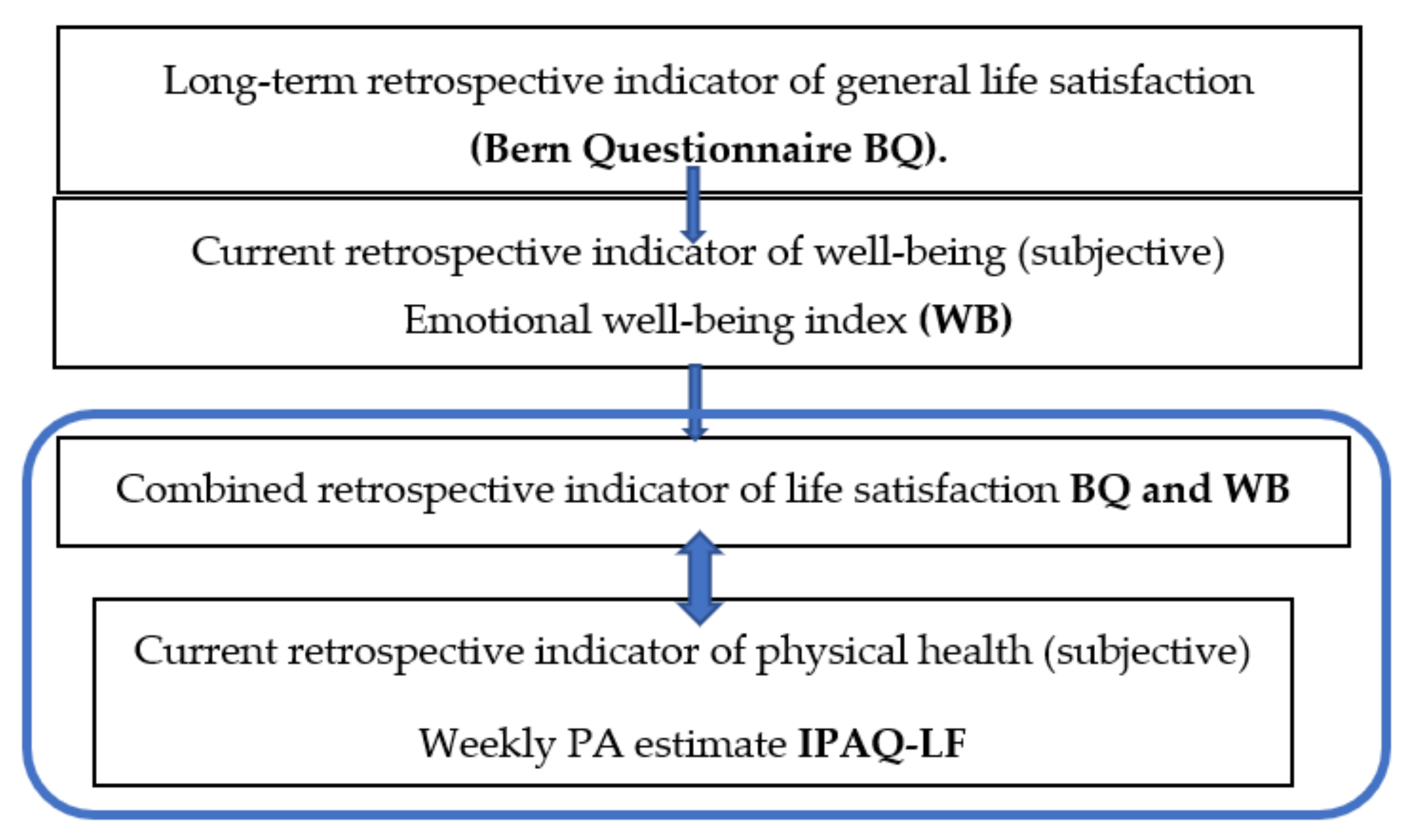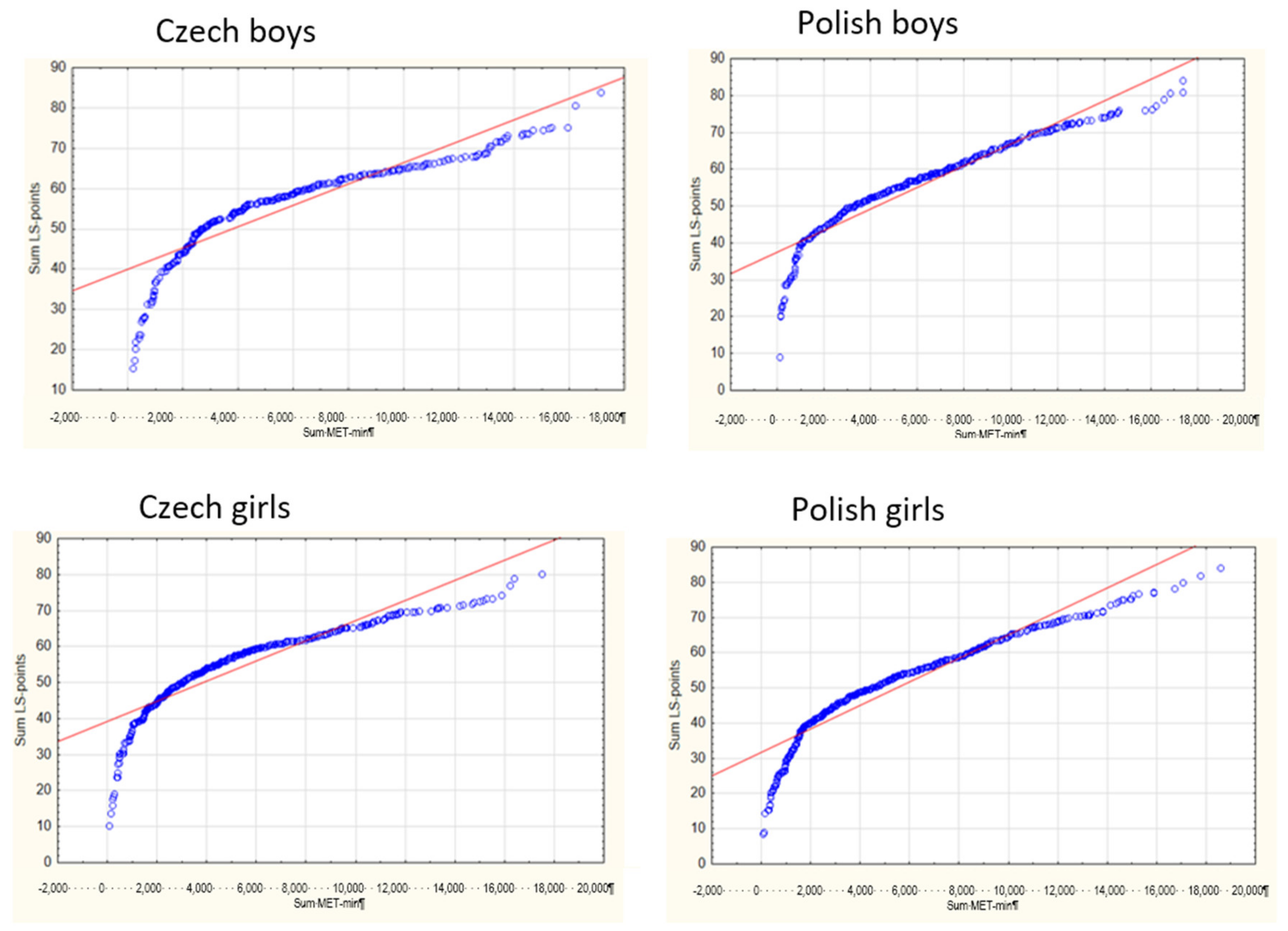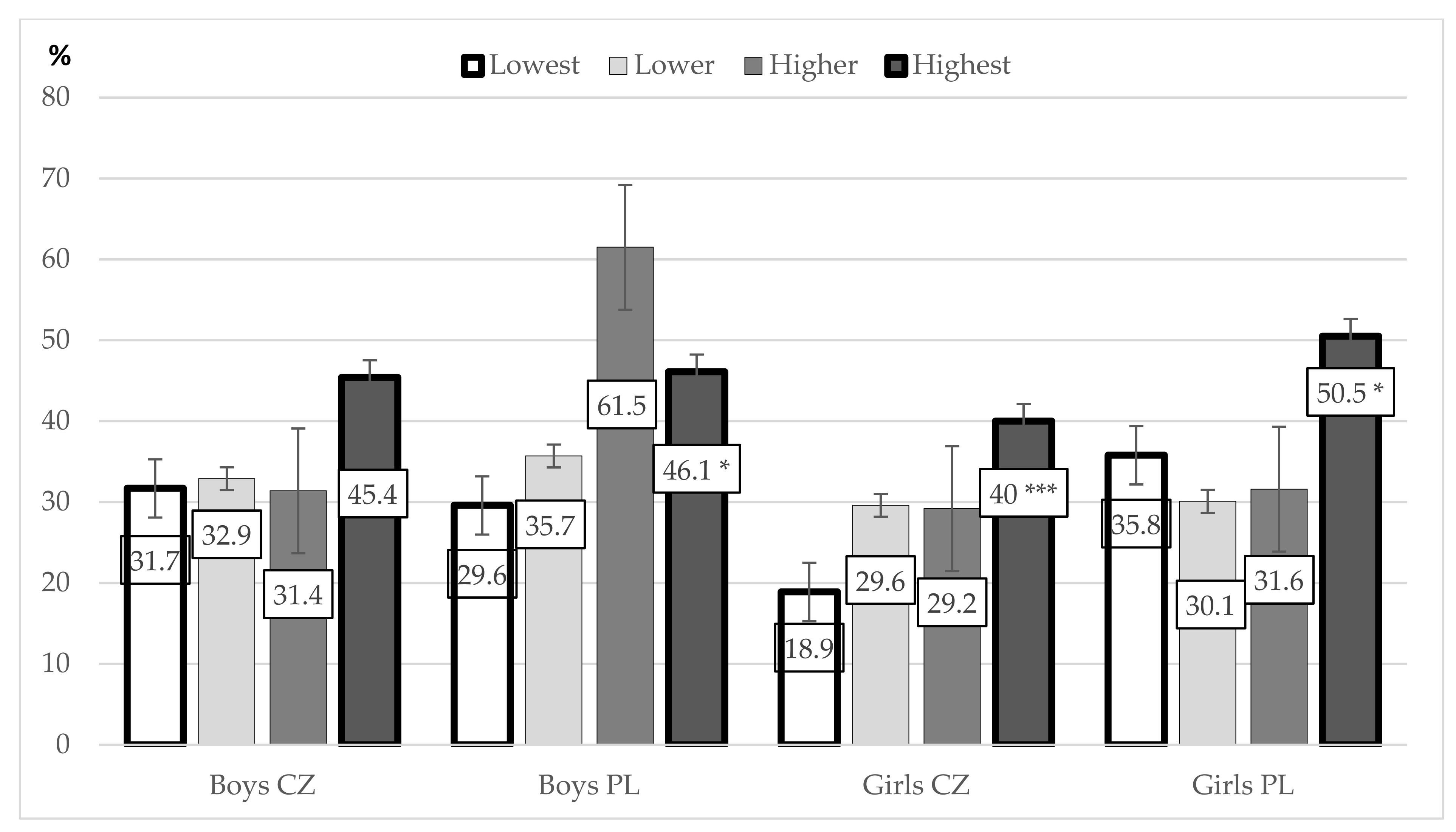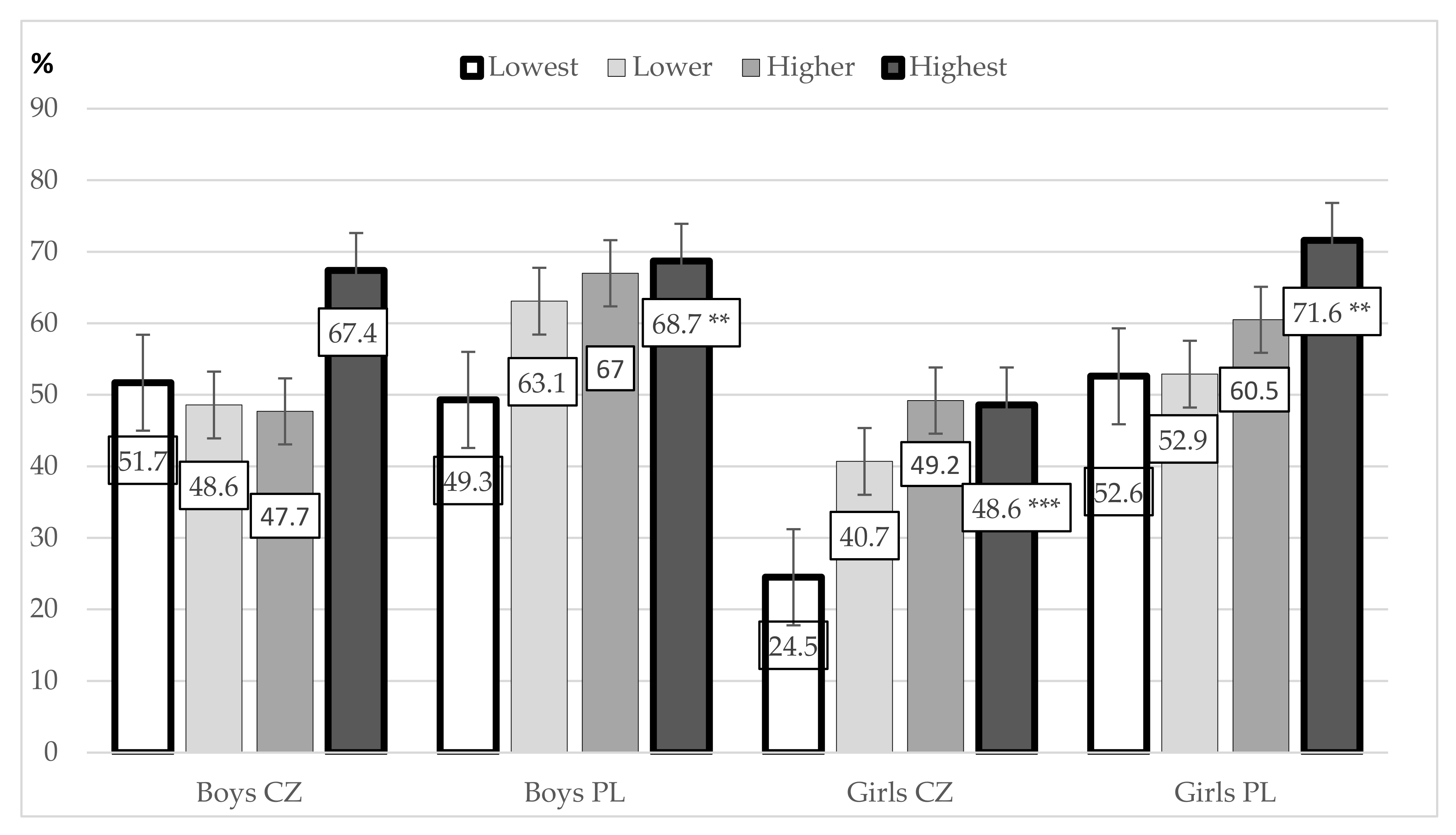Does Vigorous Physical Activity Contribute to Adolescent Life Satisfaction?
Abstract
1. Introduction
2. Materials and Methods
2.1. Study Design and Participants
2.2. Measures
- My future looks good.
- I enjoy life more than most people.
- I can cope well with the realization of my life plans.
- Whatever happens, I can always take the best of it.
- I like life.
- My life is meaningful.
- My life moves in the right direction.
- I have felt cheerful and in good spirits.
- I have felt calm and relaxed.
- I have felt active and vigorous.
- I woke up feeling fresh and rested.
- My daily life has been filled with things that interest me.
2.3. Data Analysis
2.4. Ethical Principles
3. Results
3.1. Initial Characteristics of LS and PA Among Czech and Polish Adolescents
3.2. Associations between Life Satisfaction and Types of Weekly Physical Activity
4. Discussion
Strengths and Limitations
5. Conclusions
Author Contributions
Funding
Institutional Review Board Statement
Informed Consent Statement
Data Availability Statement
Conflicts of Interest
References
- Lubans, D.R.; Plotnikoff, R.C.; Lubans, N.J. Reviewers: A systematic review of the impact of physical activity programmes on social and emotional well-being in at-risk youth. Child Adolesc. Ment. Health 2012, 17, 2–13. [Google Scholar] [CrossRef] [PubMed]
- Slapšinskaite, A.; Lukoševičiüte, J.; Šmigelskas, K. Interplay between adolescent physical activity and life satisfaction: Gender as potential effect modifier. Int. J. Public Health 2020, 65, 1355–1363. [Google Scholar] [CrossRef] [PubMed]
- Zhang, Z.; Chen, W. A Systematic review of the relationship between physical activity and happiness. J. Happiness Stud. 2019, 20, 1305–1322. [Google Scholar] [CrossRef]
- Dumith, S.; Gigante, D.P.; Domingues, M.R.; Kohl, H.W., III. Physical activity change during adolescence: A systematic review and a pooled analysis. Int. J. Epidemiol. 2011, 40, 685–698. [Google Scholar] [CrossRef] [PubMed]
- Guthold, R.; Stevens, G.A.; Riley, L.M.; Bull, F.C. Global trends in insufficient physical activity among adolescents: A pooled analysis of 298 population-based surveys with 1·6 million participants. Lancet Child. Adolesc. Health 2020, 4, 23–25. [Google Scholar] [CrossRef]
- Katzmarzyk, P.T.; Lee, I.-M.; Martin, C.K.; Blair, S.N. Epidemiology of physical activity and exercise training in the United States. Progress Cardiovasc. Dis. 2017, 60, 3–10. [Google Scholar] [CrossRef] [PubMed]
- Pate, R.R.; Schenkelberg, M.A.; Dowda, M.; McIver, K.L. Group-based physical activity trajectories in children transitioning from elementary to high school. BMC Pub. Health 2019, 19, 323. [Google Scholar] [CrossRef] [PubMed]
- Sigmundová, D.; El Ansari, W.; Sigmund, E.; Frömel, K. Secular trends: A ten-year comparison of the amount and type of physical activity and inactivity of random samples of adolescents in the Czech Republic. BMC Pub. Health 2011, 11, 731. [Google Scholar] [CrossRef] [PubMed]
- Frömel, K.; Jakubec, L.; Groffik, D.; Chmelík, F.; Svozil, Z.; Šafář, M. Physical activity of secondary school adolescents at risk of depressive symptoms. J. Sch. Health 2020, 90, 641–650. [Google Scholar] [CrossRef] [PubMed]
- Belair, M.-A.; Kohen, D.E.; Kingsbury, M.; Colman, I. Relationship between leisure time physical activity, sedentary behaviour and symptoms of depression and anxiety: Evidence from a population-based sample of Canadian adolescents. BMJ Open 2018, 8, e021119. [Google Scholar] [CrossRef]
- Allen, M.S.; Walter, E.E.; Swann, C. Sedentary behaviour and risk of anxiety: A systematic review and meta-analysis. J. Affect. Disord. 2019, 242, 5–13. [Google Scholar] [CrossRef] [PubMed]
- Ghandour, R.M.; Sherman, L.J.; Vladutiu, C.J.; Ali, M.M.; Lynch, S.E.; Bitsko, R.H.; Blumberg, S.J. Prevalence and treatment of depression, anxiety, and conduct problems in US children. J. Pediatr. 2019, 206, 256–267. [Google Scholar] [CrossRef] [PubMed]
- World Health Organization Regional Office for Europe. Adolescent mental health in the Euroepan Region; World Health Organization Regional Office for Europe: Copenhagen, Denmark, 2018. [Google Scholar]
- Patalay, P.; Gondek, D.; Moltrecht, B.; Giese, L.; Curtin, C.; Stanković, M.; Savka, N. Mental health provision in schools: Approaches and interventions in 10 European countries. Glob. Ment. Health 2017, 4, 1–12. [Google Scholar] [CrossRef] [PubMed]
- Sadler, K.; Vizard, T.; Ford, T.; Marcheselli, F.; Pearce, N.; Mandalia, D.; Davis, J.; Brodie, E.; Forbes, N.; Goodman, A.; et al. Mental Health of Children and Young People in England. 2017. Available online: https://dera.ioe.ac.uk/32622/1/MHCYP%202017%20Summary.pdf (accessed on 22 March 2020).
- Schulte-Körne, G. Mental health problems in a school setting in children and adolescents. Dtsch. Arztebl. Int. 2016, 113, 183–190. [Google Scholar] [CrossRef] [PubMed]
- Guzmán, J.; Green, J.G.; Oblath, R.; Holth, M.K. Life satisfaction mediates the association between mental health risk and perceptions of school functioning among children and adolescents. Contemp. Sch. Psychol. 2019, 24, 389–399. [Google Scholar] [CrossRef]
- Patel, V.; Saxena, S.; Lund, C.; Thornicroft, G.; Bainqana, F.; Bolton, P.; Chisholm, D.; Collins, P.Y.; Cooper, J.L.; Eaton, J.; et al. The Lancet Commission on global mental health and sustainable development. Lancet 2018, 329, 1553–1598. [Google Scholar] [CrossRef]
- Frömel, K.; Šafář, M.; Jakubec, L.; Groffik, D.; Žatka, R. Academic stress and physical activity in adolescents. Biomed Res. Int. 2020, 2020, 4696592. [Google Scholar] [CrossRef]
- Svozil, Z.; Frömel, K.; Chmelík, F.; Jakubec, L.; Groffik, D.; Šafář, M. Mental load and its compensation by physical activity in adolescents at secondary schools. Cent. Eur. J. Public Health 2015, 23, S44–S49. [Google Scholar] [CrossRef]
- Frömel, K.; Svozil, Z.; Chmelík, F.; Jakubec, L.; Groffik, D. The Role of Physical Education Lessons and Recesses in School Lifestyle of Adolescents. J. Sch. Health 2016, 86, 143–151. [Google Scholar] [CrossRef]
- Kudláček, M.; Frömel, K.; Jakubec, L.; Groffik, D. Compensation for adolescents’ school mental load by physical activity on weekend days. Int. J. Environ. Res. Public Health 2016, 13, 308. [Google Scholar] [CrossRef]
- Inchley, J.; Currie, D.; Budisavljevic, S.; Torsheim, T.; Jåstad, A.; Cosma, A.; Kelly, C.; Arnarsson, Á.M. (Eds.) Spotlight on Adolescent Health and Well-Being. Findings from the 2017/2018 Health Behaviour in School-Aged Children (HBSC) Survey in Europe and Canada; International report; WHO Regional Office for Europe: Copenhagen, Denmark, 2020. [Google Scholar]
- Chen, X.; Cai, Z.; He, J.; Fan, X. Gender differences in life satisfaction among children and adolescents: A meta-analysis. J. Happiness Stud. 2020, 21, 2279–2307. [Google Scholar] [CrossRef]
- Calmeiro, L.; Camacho, I.; de Matos, M.G. Life satisfaction in adolescents: The role of individual and social health assets. Span. J. Psychol. 2018, 21, E23. [Google Scholar] [CrossRef] [PubMed]
- Povedano-Diaz, A.; Muñiz-Rivas, M.; Vera-Perea, M. Adolescents’ life satisfaction: The role of classroom, family, self-concept and gender. Int. J. Environ. Res. Public Health 2020, 17, 19. [Google Scholar] [CrossRef] [PubMed]
- Kleszczewska, D.; Dzielska, A.; Salonna, F.; Mazur, J. The association between physical activity and general life satisfaction in lower secondary school students: The role of individual and family factors. Community Ment. Health J. 2018, 5, 1245–1252. [Google Scholar] [CrossRef]
- Due, P.; Eriksson, C.; Torsheim, T.; Potrebny, T.; Välimaa, R.; Suominen, S.; Rasmussen, M.; Currie, C.; Damgaard, M.T. Trends in high life satisfaction among adolescents in five Nordic countries 2002–2014. Nordic Welfare Res. 2019, 4, 54–66. [Google Scholar] [CrossRef]
- Von Soest, T.; Bakken, A.; Pedersen, W.; Sletten, M.A. Life satisfaction among adolescents before and during the COVID-19 pandemic. Tidsskr. Nor. Laegeforen. 2020, 140. [Google Scholar] [CrossRef]
- Smedegaard, S.; Christiansen, L.B.; Lund-Cramer, P.; Bredahl, T.; Skovgaard, T. Improving the well-being of children and youths: A randomized multicomponent, school-based, physical activity intervention. BMC Public Health 2016, 16, 1127. [Google Scholar] [CrossRef]
- Groffik, D.; Mitáš, J.; Jakubec, L.; Svozil, Z.; Frömel, K. Adolescents’ physical activity in education systems varying in the number of weekly physical education lessons. Res. Q. Exerc. Sport 2020, 91, 551–561. [Google Scholar] [CrossRef]
- Grob, A.; Lüthi, R.; Kaiser, F.G.; Flammer, A.; Mackinnon, A.; Wearing, A.J. Berner Fragebogen zum Wohlbefinden Jugendlicher (BFW). Diagnostica 1991, 37, 66–75. [Google Scholar]
- Džuka, J. Faktorová analýza modifikovanej verzie Bernského dotazníka subjektívnej pohody (BDP). Cesk. Psychol. 1995, 39, 512–521. [Google Scholar]
- Topp, C.W.; Ostergaard, S.D.; Sondergaard, S.; Bech, P. The WHO-5 Well-Being Index: A systematic review of the literature. Psychother. Psychosom. 2015, 84, 167–176. [Google Scholar] [CrossRef] [PubMed]
- Salvador-Carulla, L.; Lucas, R.; Ayuso-Mateos, J.L.; Miret, M. Use of the terms “Wellbeing” and “Quality of Life” in health sciences: A conceptual framework. Eur. J. Psychiatry 2014, 28, 50–65. [Google Scholar] [CrossRef]
- Craig, C.L.; Marshall, A.L.; Sjöström, M.; Bauman, A.E.; Booth, M.L.; Ainsworth, B.E.; Pratt, M.; Ekelund, U.; Yngve, A.; Sallis, J.F.; et al. International physical activity questionnaire: 12-country reliability and validity. Med. Sci. Sports Exerc. 2003, 35, 1381–1395. [Google Scholar] [CrossRef] [PubMed]
- Hagströmer, M.; Bergman, P.; De Bourdeaudhuij, I.; Ortega, F.B.; Ruiz, J.R.; Manios, Y.; Rey-López, J.P.; Phillipp, K.; von Berlepsch, J.; Sjöström, M.; et al. Concurrent validity of a modified version of the International Physical Activity Questionnaire (IPAQ-A) in European adolescents: The HELENA Study. Int. J. Obes. 2008, 32, S42–S48. [Google Scholar] [CrossRef] [PubMed]
- Ottevaere, C.; Huybrechts, I.; De Bourdeaudhuij, I.; Sjöström, M.; Ruiz, J.R.; Ortega, F.B.; Hagströmer, M.; Widhalm, K.; Molnár, D.; Moreno, L.A.; et al. Comparison of the IPAQ-A and Actigraph in relation to VO2max among European adolescents: The HELENA study. J. Sci. Med. Sport 2011, 14, 317–324. [Google Scholar] [CrossRef] [PubMed]
- Cull, A.; Sprangers, M.; Bjordal, K.; Aaronson, N.; West, K.; Bottomley, A. EORTC Quality of Life Group Translation Procedure, 2nd ed.; EORTC Quality of Life Unit: Brussels, Belgium, 2002. [Google Scholar]
- Frömel, K.; Groffik, D.; Mitáš, J.; Dygrýn, J.; Valach, P.; Šafář, M. Active travel of Czech and Polish adolescents in relation to their well-being: Support for physical activity and health. Int. J. Environ. Res. Public Health 2020, 17, 2001. [Google Scholar] [CrossRef]
- Mitas, J.; Sas-Nowosielski, K.; Groffik, D.; Frömel, K. The safety of the neighborhood environment and physical activity in Czech and Polish adolescents. Int. J. Environ. Res. Public Health 2018, 15, 126. [Google Scholar] [CrossRef] [PubMed]
- European Commission. EU Physical Activity Guidelines: Recommended Policy Actions in Support of Health-Enhancing Physical Activity; Education and Culture DG: Brussels, Belgium, 2008; Available online: https://eacea.ec.europa.eu/sites/eacea-site/files/eu-physical-activity-guidelines-2008.pdf (accessed on 22 March 2020).
- US Department of Health and Human Services. Healthy People 2020; US Department of Health and Human Services: Washington, DC, USA, 2010. [Google Scholar]
- Wanner, M.; Probst-Hensch, N.; Kriemler, S.; Meier, F.; Autenrieth, C.; Martin, B.W. Validation of the long international physical activity questionnaire: Influence of age and language region. Prev. Med. Rep. 2016, 3, 250–256. [Google Scholar] [CrossRef]
- Kaczmarek, L.D.; Behnke, M.; Enko, J.; Hoffman, A.; Kiciński, M.; Paruszewski, J.; Szabat, M.; Dombrowski, S.U. Would you be happier if you moved more? Physical activity focusing illusion. Curr. Psychol. 2019, 1164. [Google Scholar] [CrossRef]
- European Commission. Sport and Physical Activity. Special Eurobarometer 472. 2018. Available online: http://ec.europa.eu/commfrontoffice/publicopinion (accessed on 22 March 2020).
- Goldbeck, L.; Schimtz, T.G.; Besier, T.; Heschbach, P.; Henrich, G. Life satisfaction decreases during adolescence. Qul. Life Res. 2007, 16, 969–979. [Google Scholar] [CrossRef]
- Michel, G.; Bisegger, C.; Fuhr, D.C.; Abel, T. Age and gender differences in health-related quality of life of children and adolescents in Europe: A multilevel analysis. Qual. Life Res. 2020, 18, 1147–1157. [Google Scholar] [CrossRef] [PubMed]
- Lagestad, P.; Mikalsen, H.; Ingulfsvann, L.S.; Lyngstad, I.; Sandvik, C. Associations of participation in organized sport and self-organized physical activity in relation to physical activity level among adolescents. Front. Public Health 2019, 7, 129. [Google Scholar] [CrossRef]
- Grao-Cruces, A.; Fernández-Martínez, A.; Nuviala, A.; Pérez-Turpin, J.A. Intention to be physically active is influenced by physical activity and fitness, sedentary behaviours, and life satisfaction in adolescents. Coll. Antropol. 2015, 39, 567–573. [Google Scholar]
- Silva, A.L.; Teles, J.; Fragoso, I. Health-related quality of life of Portuguese children and adolescents according to diet quality and food intake. Qual. Life Res. 2020, 29, 2197–2207. [Google Scholar] [CrossRef] [PubMed]
- Wiium, N.; Säfvenbom, R. Participation in organized sports and self-organized physical activity: Associations with developmental factors. Int. J. Environ. Res. Public Health 2019, 16, 585. [Google Scholar] [CrossRef] [PubMed]
- Dos Santos, B.R.; Sarriera, J.C.; Bedin, L.M. Subjective well-being, life satisfaction and interpersonal relationships associated to socio-demographic and contextual variables. Appl. Res. Qual. Life 2019, 14, 819–835. [Google Scholar] [CrossRef]
- Magnúsdóttir, T.B. The Effects of Physical Activity on Life Satisfaction: A Study on ICELANDIC Adolescents. BSc in Psychology. 2017. Available online: https://skemman.is/bitstream/1946/28642/2/BSc_effects%20of%20physical%20activity%20on%20life%20satisfaction_Thelma_B.pdf (accessed on 10 July 2020).
- Hartas, D. The social context of adolescent mental health and wellbeing: Parents, friends and social media. Res. Pap. Educ. 2019. [Google Scholar] [CrossRef]
- Ruggeri, K.; Garcia-Garzon, E.; Maguire, Á.; Matz, S.; Huppert, F.A. Well-being is more than happiness and life satisfaction: A multidimensional analysis of 21 countries. Health Qual. Life Outcomes 2020, 18, 192. [Google Scholar] [CrossRef] [PubMed]
- Atienza-González, F.L.; Martinez, N.; Silva, C. Life satisfaction and self-rated health in adolescents: The relationships between them and the role of gender and age. Span. J. Psychol. 2020, 23, e4. [Google Scholar] [CrossRef]
- Morales, P.F.; Sánchez-López, M.; Moya-Martínez, P.; García-Prieto, J.C.; Martínez-Andrés, M.; García, N.L.; Martínez-Vizcaíno, V. Health-related quality of life, obesity, and fitness in schoolchildren: The Cuenca study. Qual. Life Res. 2013, 22, 1515–1523. [Google Scholar] [CrossRef]
- Currie, C.; Zanotti, C.; Morgan, A.; Currie, D.; de Looze, M.; Roberts, C.; Samdal, O.; Smith, O.R.F.; Barnekow, V. (Eds.) Social Determinants of Health and Well-Being among Young People. Health Behaviour in School-Aged Children Study: International Report from the 2009/2010 Survey; WHO Regional Office for Europe, Health Policy for Children and Adolescents: Copenhagen, Denmark, 2012. [Google Scholar]
- Fröberg, A.; Lindroos, A.-K.; Eklom, Ö.; Nyberg, G. Organised physical activity during leisure time is associated with more objectively measured physical activity among Swedish adolescents. Acta Pediatr. 2020, 109, 1815–1824. [Google Scholar] [CrossRef] [PubMed]
- Frömel, K.; Groffik, D.; Chmelík, F.; Cocca, A.; Skalik, K. Physical activity of 15–17 years old adolescents in different educational settings: A Polish-Czech study. Cent. Eur. J. Public Health 2018, 26, 137–143. [Google Scholar] [CrossRef] [PubMed]
- Powell, K.E.; King, A.C.; Buchner, D.M.; Campbell, W.W.; DiPietro, L.; Erickson, K.I.; Hillman, C.H.; Jakicic, J.M.; Janz, K.F.; Katzmarzyk, P.T.; et al. The scientific foundation for the Physical Activity Guidelines for Americans, 2nd Edition. J. Phys. Act. Health 2019, 16, 1–11. [Google Scholar] [CrossRef] [PubMed]
- Zaborskis, A.; Grincaite, M. Gender and age differences in social inequality on adolescent life satisfaction: A comparative analysis of health behaviour data from 41 countries. Int. J. Environ. Res. Public Health 2018, 15, 1297. [Google Scholar] [CrossRef]
- Kleppang, A.L.; Hartz, I.; Thurston, M.; Hagquist, C. The association between physical activity and symptoms of depression in different contexts—A cross-sectional study of Norwegian adolescents. BMC Public Health 2018, 18, 1368. [Google Scholar] [CrossRef] [PubMed]




| Characteristics | Country | n | Age (Years) | Weight (kg) | Height (cm) | BMI (kg·m−2) | ||||
|---|---|---|---|---|---|---|---|---|---|---|
| M | SD | M | SD | M | SD | M | SD | |||
| Boys | CZ | 302 | 16.72 | 1.08 | 69.80 | 12.64 | 178.90 | 7.73 | 21.74 | 3.24 |
| PL | 361 | 16.31 | 0.74 | 68.98 | 13.88 | 177.26 | 7.53 | 21.88 | 3.73 | |
| Girls | CZ | 466 | 16.61 | 1.01 | 59.24 | 9.63 | 167.61 | 6.47 | 21.06 | 3.01 |
| PL | 467 | 16.30 | 0.65 | 56.88 | 8.45 | 165.73 | 5.98 | 20.70 | 2.83 | |
| Type of Physical Activity | Gender | Country | Life Satisfaction | H | p | η2 | |||||||
|---|---|---|---|---|---|---|---|---|---|---|---|---|---|
| Lowest | Lower | Higher | Highest | ||||||||||
| Mdn | IQR | Mdn | IQR | Mdn | IQR | Mdn | IQR | ||||||
| Transportation | Boys | CZ | 672 | 1430 | 836 | 1665 | 743 | 1062 | 695 | 1436 | 0.66 | 0.884 | 0.008 |
| PL | 990 | 1905 | 875 | 1621 | 594 | 1980 | 945 | 1370 | 2.72 | 0.437 | 0.001 | ||
| Girls | CZ | 767 | 1155 | 990 | 1451 | 693 | 1478 | 924 | 1400 | 2.26 | 0.520 | 0.002 | |
| PL | 660 | 1215 | 660 | 1370 | 718 | 1908 | 792 | 1919 | 1.19 | 0.773 | 0.004 | ||
| Recreation | Boys | CZ | 1049 | 2592 | 1128 | 1602 | 986 | 1899 | 1833 | 2198 | 14.62 a | 0.002 | 0.039 * |
| PL | 693 | 1760 | 846 | 2192 | 931 | 2435 | 1188 | 2478 | 4.06 | 0.255 | 0.003 | ||
| Girls | CZ | 587 | 1337 | 990 | 1871 | 1188 | 1722 | 1374 | 1881 | 19.11 a | <0.001 | 0.035 * | |
| PL | 491 | 1551 | 630 | 1485 | 692 | 1581 | 938 | 2226 | 14.06 a | 0.003 | 0.024 * | ||
| Vigorous | Boys | CZ | 900 | 2160 | 840 | 2040 | 765 | 1980 | 1500 | 2760 | 7.57 | 0.056 | 0.015 * |
| PL | 450 | 2250 | 720 | 2220 | 1980 | 2820 | 1440 | 3180 | 17.29 a | <0.001 | 0.040 * | ||
| Girls | CZ | 180 | 1170 | 540 | 1620 | 615 | 1440 | 1020 | 1860 | 13.52 a | 0.004 | 0.023 * | |
| PL | 360 | 1800 | 420 | 1800 | 570 | 1680 | 1260 | 2820 | 12.60 a | 0.006 | 0.021 * | ||
| Moderate | Boys | CZ | 1160 | 2530 | 1210 | 2640 | 1239 | 1700 | 2130 | 3120 | 6.45 | 0.092 | 0.012 * |
| PL | 1300 | 3220 | 1550 | 2528 | 1740 | 3310 | 1460 | 2700 | 2.14 | 0.544 | 0.002 | ||
| Girls | CZ | 730 | 1020 | 1015 | 1660 | 890 | 1680 | 1270 | 1695 | 11.52 a | 0.009 | 0.018 * | |
| PL | 1005 | 1860 | 1260 | 2200 | 1290 | 2140 | 1720 | 2460 | 10.04 a | 0.018 | 0.015 * | ||
| Walking | Boys | CZ | 1254 | 2285 | 1436 | 2063 | 1295 | 2673 | 1254 | 1980 | 0.87 | 0.832 | 0.007 |
| PL | 1617 | 2987 | 1378 | 2384 | 990 | 2574 | 1683 | 2409 | 3.41 | 0.332 | 0.001 | ||
| Girls | CZ | 1411 | 2492 | 1964 | 2921 | 1246 | 2541 | 1749 | 2541 | 5.97 | 0.113 | 0.006 | |
| PL | 1551 | 2541 | 1221 | 2360 | 1452 | 2805 | 1617 | 2739 | 0.67 | 0.880 | 0.005 | ||
| Total (vigorous, moderate, walking) | Boys | CZ | 4106 | 5629 | 4241 | 4590 | 4017 | 4368 | 5552 | 6432 | 6.76 | 0.080 | 0.013 * |
| PL | 4581 | 5877 | 5122 | 5540 | 6630 | 5774 | 5623 | 6049 | 4.72 | 0.193 | 0.005 | ||
| Girls | CZ | 3173 | 3716 | 4421 | 5061 | 3890 | 3887 | 5063 | 5234 | 12.98 a | 0.005 | 0.022 * | |
| PL | 3720 | 5200 | 4546 | 6287 | 4541 | 5296 | 4782 | 6493 | 8.27 a | 0.041 | 0.011 * | ||
Publisher’s Note: MDPI stays neutral with regard to jurisdictional claims in published maps and institutional affiliations. |
© 2021 by the authors. Licensee MDPI, Basel, Switzerland. This article is an open access article distributed under the terms and conditions of the Creative Commons Attribution (CC BY) license (http://creativecommons.org/licenses/by/4.0/).
Share and Cite
Chmelík, F.; Frömel, K.; Groffik, D.; Šafář, M.; Mitáš, J. Does Vigorous Physical Activity Contribute to Adolescent Life Satisfaction? Int. J. Environ. Res. Public Health 2021, 18, 2236. https://doi.org/10.3390/ijerph18052236
Chmelík F, Frömel K, Groffik D, Šafář M, Mitáš J. Does Vigorous Physical Activity Contribute to Adolescent Life Satisfaction? International Journal of Environmental Research and Public Health. 2021; 18(5):2236. https://doi.org/10.3390/ijerph18052236
Chicago/Turabian StyleChmelík, František, Karel Frömel, Dorota Groffik, Michal Šafář, and Josef Mitáš. 2021. "Does Vigorous Physical Activity Contribute to Adolescent Life Satisfaction?" International Journal of Environmental Research and Public Health 18, no. 5: 2236. https://doi.org/10.3390/ijerph18052236
APA StyleChmelík, F., Frömel, K., Groffik, D., Šafář, M., & Mitáš, J. (2021). Does Vigorous Physical Activity Contribute to Adolescent Life Satisfaction? International Journal of Environmental Research and Public Health, 18(5), 2236. https://doi.org/10.3390/ijerph18052236







